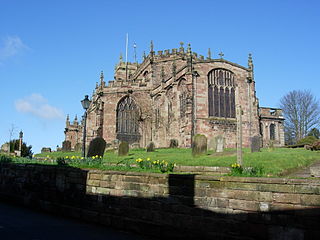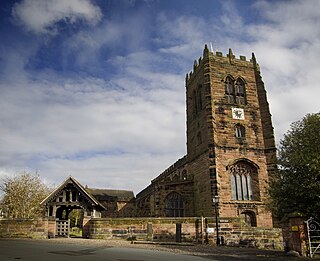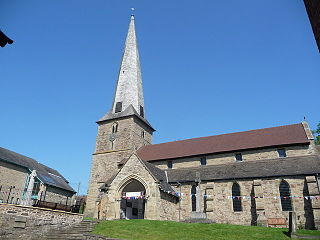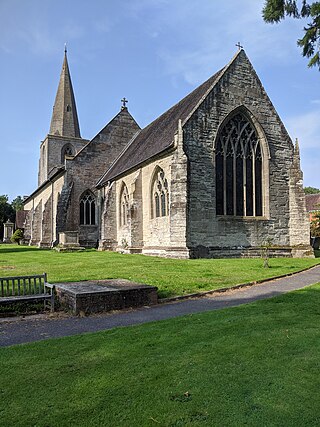
St Oswald's Church stands on the highest point in the market town of Malpas, Cheshire, England, on or near the site of a Norman motte and bailey castle. The church is recorded in the National Heritage List for England as a designated Grade I listed building and is recognised as being one of the best examples in Cheshire of a late 15th to early 16th-century church. It is an active Anglican parish church in the diocese of Chester, the archdeaconry of Chester and the deanery of Malpas. Its benefice is combined with those of St John, Threapwood, and Holy Trinity, Bickerton. Alec Clifton-Taylor includes it in his list of 'best' English parish churches.

St Mary's Church is an Anglican parish church in the village of Newbold Astbury, Cheshire, England. It is recorded in the National Heritage List for England as a designated Grade I listed building, and its architecture has been praised by a number of writers.

St Mary and All Saints Church is in the centre of the village of Great Budworth, Cheshire, England. It is an active Anglican parish church in the diocese of Chester, the archdeaconry of Chester and the deanery of Great Budworth. The church is recorded in the National Heritage List for England as a designated Grade I listed building. Clifton-Taylor includes it in his list of 'best' English parish churches. Richards describes it as "one of the finest examples of ecclesiastical architecture remaining in Cheshire". The authors of the Buildings of England series express the opinion that it is "one of the most satisfactory Perpendicular churches of Cheshire and its setting brings its qualities out to perfection".

St Mary's Church is a redundant Anglican church in the small village of Thornton-le-Moors, Cheshire, England. The church is recorded in the National Heritage List for England as a designated Grade I listed building, and it is in the care of the Churches Conservation Trust.

St John the Baptist's Church is in the village of Aldford, Cheshire, England. The church is recorded in the National Heritage List for England as a designated Grade II listed building. It is an active Anglican parish church in the diocese of Chester, the archdeaconry of Chester and the deanery of Malpas. Its benefice is combined with those of St Peter, Waverton and St Mary, Bruera. It is described by the authors of the Buildings of England series as "expensive" and "stiffly conventional".

Lancaster Priory, formally the Priory Church of St Mary, is the Church of England parish church of the city of Lancaster, Lancashire, England. It is located near Lancaster Castle and since 1953 has been designated a Grade I listed building. It is in the deanery of Lancaster, the archdeaconry of Lancaster and the Diocese of Blackburn. Its benefice is combined with that of St John and St Anne.

St Wilfrid's Church is an Anglican church in the village of Ribchester in Lancashire, England, which is situated close to the site of a Roman fort. It is an active parish church in the Diocese of Blackburn. It is recorded in the National Heritage List for England as a designated Grade I listed building.

St Swithun's Church is a historic Anglican church in the village of Brookthorpe, Gloucestershire, England under the care of The Churches Conservation Trust. It is recorded in the National Heritage List for England as a designated Grade II* listed building.

The Church of St Mary and All Saints is an Anglican church in the village of Whalley, Lancashire, England. It is an active parish church in the Diocese of Blackburn. A church probably existed on the site in Anglo-Saxon times and the current building dates from the 13th century. It is recorded in the National Heritage List for England as a designated Grade I listed building.

St Mary's Church, Patshull, is a redundant Anglican church in the parish of Pattingham and Patshull, Staffordshire, England, and is situated near Patshull Hall. It is recorded in the National Heritage List for England as a designated Grade II* listed building, and is under the care of the Churches Conservation Trust. The church stands in parkland beside a lake.

St Leonard's Church is an Anglican church in the village of Apethorpe in Northamptonshire, England. It is an active parish church in the Diocese of Peterborough. It has been designated a Grade I listed building by English Heritage.

St Mary's is a parish church in Lenham, Kent, England, begun in the 12th century with additions in the next three centuries. It is a Grade I listed building.

St Michael's Church is in Church Lane, Aughton, Lancashire, England. It is an active Anglican parish church in the deanery of Ormskirk, the archdeaconry of Wigan & West Lancashire, and the diocese of Liverpool. Its benefice is united with that of Holy Trinity, Bickerstaffe. The church is recorded in the National Heritage List for England as a designated Grade I listed building.

St Michael's Church is in the village of Barton, Cumbria, England. It is an active Anglican parish church in the deanery of Penrith, the archdeaconry of Carlisle, and the diocese of Carlisle. Its benefice is united with those of St Paul, Pooley Bridge, St Peter, Martindale, and St Martin, Martindale. The church is recorded in the National Heritage List for England as a designated Grade I listed building. It stands in a circular churchyard, and possesses the only central Norman tower on a medieval church in Cumbria.

St Mary's Church is in the town of Kirkby Lonsdale, Cumbria, England. It is an active Anglican parish church in the deanery of Kendal, the archdeaconry of Westmorland and Furness, and the diocese of Carlisle. Its benefice is united with those of six local churches to form the Kirkby Lonsdale Team Ministry. The church contains Norman architecture and is recorded in the National Heritage List for England as a designated Grade I listed building.

St Mary's Church is a parish church in Hunton, Kent. It was begun in the late 11th or the 12th century and is a Grade I listed building.

St Mary's Church is on Church Street, Cleobury Mortimer, Shropshire, England. It is an active Anglican parish church in the deanery of Ludlow, the archdeaconry of Ludlow, and the diocese of Hereford. Its benefice is united with those of six local parishes to form the Cleobury Benefice. The church is recorded in the National Heritage List for England as a designated Grade I listed building. It is notable for its shingled twisted spire.

St Michael's Church is in the village of High Ercall, Shropshire, England. It is an active Anglican parish church in the deanery of Wrockwardine, the archdeaconry of Salop, and the diocese of Lichfield. Its benefice is united with those of twelve local churches. The church is recorded in the National Heritage List for England as a designated Grade I listed building.

St Germanus' Church is a Church of England church in Rame, Cornwall, England, UK. Much of the existing church dates to the 13th and 15th centuries. It has been Grade I listed since 1960.

The Church of St Mary Magdalene is an Anglican church in the village of Tanworth-in-Arden, in Warwickshire, England, and in the Diocese of Birmingham. The building dates from the 13th and 14th centuries, with modifications in the 18th and 19th centuries. It is Grade I listed.























